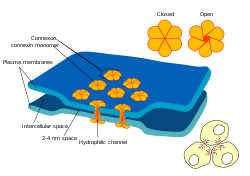
Back تقاطعات الفجوة بين الخلايا Arabic Unions comunicants Catalan Mezerový spoj Czech Gap Junction German Unión gap Spanish Gap lotura Basque اتصال شکاف Persian Aukkoliitos Finnish Jonction communicante French Unión comunicante Galician
This article's tone or style may not reflect the encyclopedic tone used on Wikipedia. (April 2024) |
| Gap junction | |
|---|---|
 Vertebrate gap junction | |
| Identifiers | |
| MeSH | D017629 |
| TH | H1.00.01.1.02024 |
| FMA | 67423 |
| Anatomical terminology | |
Gap junctions are membrane channels between adjacent cells that allow the direct exchange of cytoplasmic substances.[1] Substances exchanged include small molecules, substrates, and metabolites.[1]
Gap junctions were first described as close appositions as other tight junctions, but following electron microscopy studies in 1967, they were renamed gap junctions to distinguish them from tight junctions.[2] They bridge a 2-4 nm gap between cell membranes.[3]
Gap junctions use protein complexes known as connexons to connect one cell to another. The proteins are called connexins. Gap junction proteins include the more than 26 types of connexin, and at least 12 non-connexin components that make up the gap junction complex or nexus.[4] These components include the tight junction protein ZO-1—a protein that holds membrane content together and adds structural clarity to a cell,[5] sodium channels,[6] and aquaporin.[7][8]
More gap junction proteins have become known due to the development of next-generation sequencing. Connexins were found to be structurally homologous between vertebrates and invertebrates but different in sequence.[9] As a result, the term innexin is used to differentiate invertebrate connexins.[10] There are more than 20 known innexins,[11] along with unnexins in parasites and vinnexins in viruses.
An electrical synapse is a gap junction that can transmit action potentials between neurons. Such synapses create bidirectional continuous-time electrical coupling[12][13] between neurons. Connexon pairs act as generalized regulated gates for ions and smaller molecules between cells. Hemichannel connexons form channels to the extracellular environment.[14][15][16][17]
A gap junction or macula communicans is different from an ephaptic coupling that involves electrical signals external to the cells.[18][19]
- ^ a b Talukdar, S; Emdad, L; Das, SK; Fisher, PB (2 January 2022). "GAP junctions: multifaceted regulators of neuronal differentiation". Tissue Barriers. 10 (1): 1982349. doi:10.1080/21688370.2021.1982349. PMC 8794256. PMID 34651545.
- ^ Brightman MW, Reese TS (March 1969). "Junctions between intimately apposed cell membranes in the vertebrate brain". J. Cell Biol. 40 (3): 648–677. doi:10.1083/jcb.40.3.648. PMC 2107650. PMID 5765759.
- ^ Revel, J. P.; Karnovsky, M. J. (1 June 1967). "Hexagonal Array of Subunits in Intercellular Junctions of the Mouse Heart and Liver". Journal of Cell Biology. 33 (3): C7–12. doi:10.1083/jcb.33.3.C7. PMC 2107199. PMID 6036535.
- ^ Hervé, Jean-Claude; Bourmeyster, Nicolas; Sarrouilhe, Denis; Duffy, Heather S. (May 2007). "Gap junctional complexes: From partners to functions". Progress in Biophysics and Molecular Biology. 94 (1–2): 29–65. doi:10.1016/j.pbiomolbio.2007.03.010. PMID 17507078.
- ^ Gilleron, Jérome; Carette, Diane; Fiorini, Céline; Benkdane, Merieme; Segretain, Dominique; Pointis, Georges (March 2009). "Connexin 43 gap junction plaque endocytosis implies molecular remodelling of ZO-1 and c-Src partners". Communicative & Integrative Biology. 2 (2): 104–106. doi:10.4161/cib.7626. PMC 2686357. PMID 19704902.
- ^ Cite error: The named reference
Localization of Na + channel clustewas invoked but never defined (see the help page). - ^ Yu, Xun Sean; Yin, Xinye; Lafer, Eileen M.; Jiang, Jean X. (June 2005). "Developmental Regulation of the Direct Interaction between the Intracellular Loop of Connexin 45.6 and the C Terminus of Major Intrinsic Protein (Aquaporin-0)". Journal of Biological Chemistry. 280 (23): 22081–22090. doi:10.1074/jbc.M414377200. PMID 15802270.
- ^ Cite error: The named reference
Gruijters, WTM 1989 509–13was invoked but never defined (see the help page). - ^ Phelan, Pauline; Stebbings, Lucy A.; Baines, Richard A.; Bacon, Jonathan P.; Davies, Jane A.; Ford, Chris (January 1998). "Drosophila Shaking-B protein forms gap junctions in paired Xenopus oocytes". Nature. 391 (6663): 181–184. Bibcode:1998Natur.391..181P. doi:10.1038/34426. PMID 9428764. S2CID 205003383.
- ^ Phelan, Pauline; Bacon, Jonathan P.; A. Davies, Jane; Stebbings, Lucy A.; Todman, Martin G. (September 1998). "Innexins: a family of invertebrate gap-junction proteins". Trends in Genetics. 14 (9): 348–349. doi:10.1016/s0168-9525(98)01547-9. PMC 4442478. PMID 9769729.
- ^ Ortiz, Jennifer; Bobkov, Yuriy V; DeBiasse, Melissa B; Mitchell, Dorothy G; Edgar, Allison; Martindale, Mark Q; Moss, Anthony G; Babonis, Leslie S; Ryan, Joseph F (3 February 2023). "Independent Innexin Radiation Shaped Signaling in Ctenophores". Molecular Biology and Evolution. 40 (2): msad025. doi:10.1093/molbev/msad025. PMC 9949713. PMID 36740225.
- ^ Cite error: The named reference
:0was invoked but never defined (see the help page). - ^ Cite error: The named reference
:1was invoked but never defined (see the help page). - ^ Furshpan, E. J.; Potter, D. D. (August 1957). "Mechanism of Nerve-Impulse Transmission at a Crayfish Synapse". Nature. 180 (4581): 342–343. Bibcode:1957Natur.180..342F. doi:10.1038/180342a0. PMID 13464833. S2CID 4216387.
- ^ Lampe, Paul D.; Lau, Alan F. (2004). "The effects of connexin phosphorylation on gap junctional communication". The International Journal of Biochemistry & Cell Biology. 36 (7): 1171–86. doi:10.1016/S1357-2725(03)00264-4. PMC 2878204. PMID 15109565.
- ^ Lampe, Paul D.; Lau, Alan F. (2000). "Regulation of gap junctions by phosphorylation of connexins". Archives of Biochemistry and Biophysics. 384 (2): 205–15. doi:10.1006/abbi.2000.2131. PMID 11368307.
- ^ Scemes, Eliana; Spray, David C.; Meda, Paolo (April 2009). "Connexins, pannexins, innexins: novel roles of "hemi-channels"". Pflügers Archiv: European Journal of Physiology. 457 (6): 1207–1226. doi:10.1007/s00424-008-0591-5. PMC 2656403. PMID 18853183.
- ^ Martinez-Banaclocha, Marcos (13 February 2020). "Astroglial Isopotentiality and Calcium-Associated Biomagnetic Field Effects on Cortical Neuronal Coupling". Cells. 9 (2): 439. doi:10.3390/cells9020439. PMC 7073214. PMID 32069981.
- ^ Parker, David (22 December 2022). "Neurobiological reduction: From cellular explanations of behavior to interventions". Frontiers in Psychology. 13: 987101. doi:10.3389/fpsyg.2022.987101. PMC 9815460. PMID 36619115.